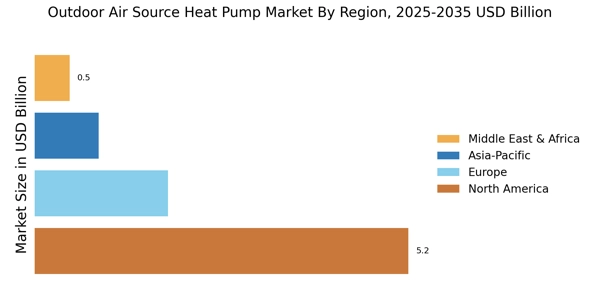Growing Awareness of Energy Costs and Savings
The Outdoor Air Source Heat Pump Market is significantly influenced by the growing awareness of energy costs and potential savings associated with heat pump systems. As energy prices fluctuate, consumers are increasingly seeking cost-effective heating solutions that can mitigate their energy bills. Air source heat pumps, known for their high efficiency, can lead to substantial savings over time, making them an attractive investment. Data suggests that homeowners can save up to 50% on heating costs compared to traditional heating methods. This financial incentive is driving more consumers to consider air source heat pumps as a viable alternative. Additionally, as energy efficiency becomes a priority for many households, the Outdoor Air Source Heat Pump Market is likely to see continued growth as consumers seek to balance comfort with cost-effectiveness.
Supportive Government Policies and Incentives
Supportive government policies and incentives are pivotal in shaping the Outdoor Air Source Heat Pump Market. Many governments are implementing programs aimed at promoting energy efficiency and reducing greenhouse gas emissions. These initiatives often include financial incentives such as tax credits, rebates, and grants for homeowners who install energy-efficient systems, including air source heat pumps. For example, certain regions have reported a 20% increase in installations due to such incentives. Furthermore, regulatory frameworks are increasingly favoring renewable energy technologies, which enhances the market appeal of air source heat pumps. As these policies continue to evolve, they are likely to provide a conducive environment for growth within the Outdoor Air Source Heat Pump Market.
Increased Urbanization and Housing Development
Increased urbanization and housing development are driving factors in the Outdoor Air Source Heat Pump Market. As urban areas expand, there is a rising demand for efficient heating and cooling solutions in residential and commercial buildings. New housing developments are increasingly incorporating energy-efficient technologies, including air source heat pumps, as standard practice. This trend is particularly evident in regions where building codes are becoming more stringent regarding energy efficiency. Recent data indicates that new constructions are adopting heat pump systems at a rate of approximately 30%, reflecting a shift towards sustainable building practices. Consequently, the Outdoor Air Source Heat Pump Market is poised for growth as urbanization continues to influence consumer preferences and building standards.
Rising Demand for Sustainable Heating Solutions
The Outdoor Air Source Heat Pump Market is experiencing a notable surge in demand for sustainable heating solutions. As consumers become increasingly aware of environmental issues, there is a growing preference for energy-efficient systems that reduce carbon footprints. This trend is further supported by the fact that air source heat pumps can provide heating and cooling with significantly lower energy consumption compared to traditional systems. In many regions, the market has seen a shift towards renewable energy sources, with air source heat pumps being recognized as a viable option. According to recent data, the adoption of these systems is projected to grow by approximately 15% annually, indicating a robust market trajectory. This rising demand is likely to drive innovation and investment in the Outdoor Air Source Heat Pump Market.
Technological Advancements in Heat Pump Efficiency
Technological advancements play a crucial role in shaping the Outdoor Air Source Heat Pump Market. Innovations in compressor technology, refrigerants, and control systems have led to significant improvements in the efficiency and performance of air source heat pumps. For instance, the introduction of variable speed compressors allows for better modulation of heating and cooling output, enhancing overall system efficiency. Recent studies indicate that modern air source heat pumps can achieve efficiencies exceeding 300%, making them an attractive option for consumers. Furthermore, the integration of smart technologies enables users to optimize their energy usage, further enhancing the appeal of these systems. As technology continues to evolve, the Outdoor Air Source Heat Pump Market is expected to benefit from increased consumer adoption and satisfaction.


















Leave a Comment